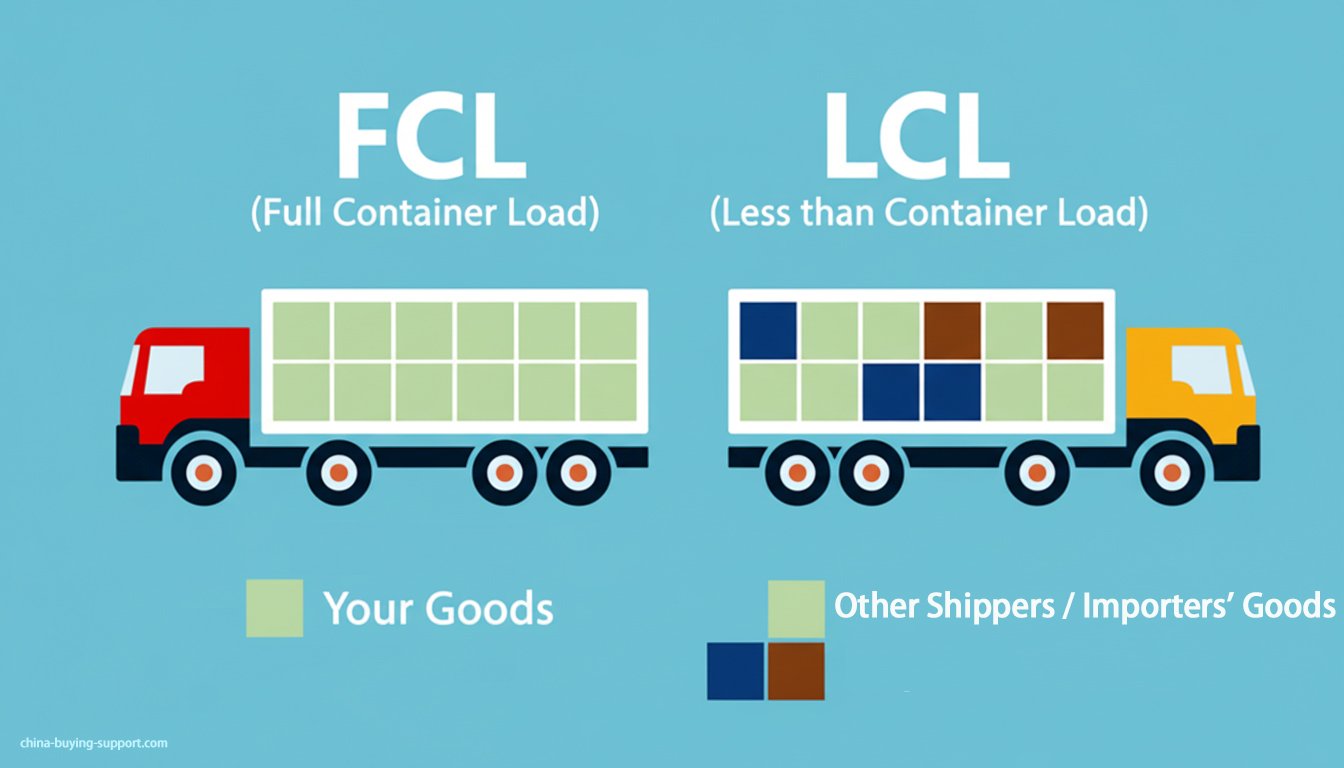FCL vs LCL: How to Choose the Right Ocean Freight
What You’ll Find in This Article?
- What FCL and LCL really mean (in plain English)
- A quick side-by-side comparison
- A simple break-even framework (with an example)
- When to choose LCL vs FCL (real-world scenarios)
- Costs, time, risk, packaging, and Incoterms—explained
- A handy checklist + FAQs you can give your team
First Things First: What Are FCL and LCL?

FCL (Full Container Load) means your goods occupy the entire container. LCL (Less than Container Load) combines multiple shippers’ cargo – ideal for smaller volumes.
Let’s start by imagining you’re moving into a new apartment. You have two choices: rent the whole place for yourself, or share a larger apartment with roommates. This is the easiest way to understand FCL and LCL.
What is FCL (Full Container Load)? – Your Private Apartment.
FCL is exactly what it sounds like: you get a full container all to yourself. Whether you fill it full with cargo or only use half the space, that entire container is exclusively yours for the journey. You book a whole container (20’ or 40’). Your goods is the only cargo inside. It’s sealed at your supplier’s factory and isn’t opened again until it reaches you or your designated destination. It’s the most secure and straightforward way to ship.
What is LCL (Less than Container Load)? – The Co-Living Space.
LCL, on the other hand, is the “shared apartment” option. If your cargo isn’t large enough to fill a whole container, you can book space in a shared one. Your goods will be consolidated at a warehouse (known as a Container Freight Station, or CFS) with cargo from several other shippers / factories. Once container loaded, then sealed and shipped. At the destination, it’s taken to another CFS to be unpacked and sorted. It’s a brilliant way to ship smaller volumes without paying for a full container.
In short: FCL = your own container; LCL = shared space.
FCL vs LCL at a Glance
| Factor | LCL (Less than Container Load) | FCL (Full Container Load) |
|---|---|---|
| Cost Structure | Pay by cubic meter CBM (or by ton – W/M *) + CFS/local fees; good for small volumes | Pay flat container rate + local port/handling fee; economical for larger volumes |
| Transit & Reliability | Usually a bit slower (extra time for consolidation + deconsolidation steps) | Often faster & more predictable (fewer handlings) |
| Risk & Handling | More handlings, mixed cargo; higher scuff/dent/moisture risk if poorly packed | Fewer handlings. Sealed at origin, opened by you |
| Flexibility | Ship small & often; easy to scale up/down | Best for steady flows or big, bulky shipments |
| Documentation & Ops | Straightforward, but more touchpoints at CFS | Clean process; door-to-door control is simpler |
| Pricing | Complex, need to check and confirm all destination charges | Simple, all-in pricing |
| Customs | Shared risk. Delays if any shipment has issues | Straightforward. Your cargo, your customs |
*W/M rule (for LCL): charges are by weight or measure, typically 1 W/M = 1 CBM or 1,000 kg, whichever is higher.
A Simple Break-Even Framework (Bring This To Your Next Rate Review)
Step 1: Gather two quotes
- LCL: ocean rate per CBM + origin/destination CFS & documentation fees + delivery.
- FCL: all-in container rate + origin/destination port/handling + delivery.
Step 2: Calculate
- Total LCL ≈ (CBM × LCL rate) + LCL local fees + delivery
- Total FCL ≈ FCL container rate + FCL local fees + delivery
Step 3: Compare totals
The cross-over volume is where the two totals meet. Above that, FCL is usually better.
Quick example (illustrative only):
LCL ocean: $45/CBM; LCL local fees: $220 total; Volume: 12 CBM
FCL (20’): $1,350 all-in; FCL local fees: $180 total
-> LCL total ≈ 12×45 + 220 = $760
-> FCL total ≈ 1,350 + 180 = $1,530
-> At 12 CBM, LCL wins. If your volume rises to 24 CBM, re-run the math—FCL likely flips to cheaper.
When LCL Is The Smarter Choice
- Small loads (e.g., samples, first-time test quantities, first PO, 1–12 CBM range).
- Irregular demand—you don’t want to sit on inventory.
- Many SKUs, light cartons—paying by CBM remains efficient.
- Budget spread—lower cash outlay per shipment; ship little and often.
Pro tips for LCL
- Pack strong: double-wall cartons, corner protectors, shrink wrap on pallets.
- Moisture control: desiccants and proper lining help, especially for paper-made products—shared boxes see varied climates.
- Label well: clear marks reduce CFS errors and mis-sorts.
When FCL Is The Better to Go with
- Mid-to-large volumes (your break-even shows FCL cheaper).
- Fragile/high-value/sensitive goods—fewer handlings, sealed security.
- Tight timelines—you skip consolidation queues; transit is more predictable.
- Bulky items (furniture, machinery) that cube-out a container.
Pro tips for FCL
- Choose the right container: 20’ for dense/heavy; 40’GP/40’HC for voluminous/light.
- Load plan: use dunnage, airbags, and a simple load map for balance and stability.
- Avoid delay/demurrage: pre-book truckers and arrange docs early.
Costs—What’s Actually Inside The Numbers?
LCL
- Freight by CBM (or W/M).
- CFS fees: consolidation/deconsolidation, terminal handling, docs.
- Minimum charge: many lanes apply a 1 CBM minimum.
- Delivery: last-mile from CFS/port to your door.
FCL
- Ocean freight for the container (20’, 40’, 40’HC).
- Terminal handling at both ends, customs clearance, docs.
- Pre-carriage/on-carriage: drayage/door delivery, chassis, fuel surcharges.
- Possible extras: liftgate, appointments, residential delivery, port storage.
Tip: Ask your forwarder to separate ocean vs local charges and specify what’s included at both ends. Clarity kills surprises.
Time & Reliability
- LCL adds extra processes: cargo arrives at CFS → waits for consolidation → sails → deconsolidation at destination → pick-up/delivery. That usually means a few extra days vs FCL.
- FCL is a straight line: factory loading → truck to port → vessel → port → delivery. Fewer handlings = more predictable ETAs.
If your boat departing date is confirmed, pad some buffer for LCL or step up to FCL.
Risk & Packaging (Don’t Skip This)
- LCL: more handlings and neighbors. Invest in palletization, corner boards, straps, moisture protection, and “do not stack” cones if needed.
- FCL: safer by design but not risk-free. Use blocking & bracing, record photos at stuffing.
- Insurance: cargo insurance is inexpensive relative to the headache. Buy it.
Incoterms & Who Pays What (Quick Guide)
- EXW / FCA: you (the buyer) usually take more origin costs than the shipper / seller does.
- FOB: seller covers origin to on-board; you take sea freight + destination charges.
- CIF/CFR: seller covers sea freight (with/without insurance); you still handle destination charges.
- Always align Incoterms with how you ship (LCL vs FCL) so there’s no gap in responsibility.
Two Quick Example
- 8 CBM of consumer electronics, monthly
You prefer nimble launches and light inventory. LCL keeps cash flow smooth and meets demand. - 24 CBM of flat-pack furniture, every 6–8 weeks
You’re near or past the cross-over. FCL likely wins on cost and damages less.
Common Mistakes to Avoid
- Chasing the lowest ocean rate but ignoring local fees (both big matters).
- Under-estimating packaging for LCL.
- Forgetting demurrage planning for FCL.
- Assuming “LCL = always slower”—sometimes a direct consol beats a rolled FCL (“Rolled FCL” means your full container load (FCL) was delayed and could not be loaded onto the planned vessel as scheduled. It is typically “rolled over” to the next available sailing, often due to overbooking or port congestion.). Ask for the service pattern.
- Mixing Incoterms with the wrong shipping arrangement.
Your Quick Decision Checklist
- My volume (CBM) and weight are confirmed
- I compared LCL vs FCL with all local charges and delivery
- Timeline allows for LCL’s extra steps (if choosing LCL)
- Packaging plan matches the risk profile
- Incoterms match who handles origin/destination
- Trucking booked; documents ready; insurance arranged
FAQs
Is FCL always cheaper than LCL?
No. It depends on your volume, lane, season, and local fees. Below your cross-over, LCL is usually cheaper.
How do I estimate my CBM?
Length × Width × Height (meters) × number of packages. Round up sensibly and check if your lane has a 1 CBM minimum.
How much slower is LCL?
Expect a bit of extra time for consolidation/deconsolidation. Get the service schedule; some direct consoled LCL moves are very competitive.
What about fragile or high-value cargo?
If the budget allows, FCL + strong blocking/bracing is safer. If using LCL, over-invest in packaging and insurance.
Can I split shipments—some LCL, some FCL?
Absolutely. Many shippers run LCL for steady small flows and FCL when volume spikes.
20’ or 40’ Container for FCL?
Dense/heavy goods: often 20’. Voluminous/light goods: 40’/40’HC to avoid “cubing out.”
Let Me Say A Few Final Words
There isn’t a “best” option in a vacuum. There’s only the best fit for this shipment, on this lane, at today’s rates. Run the quick math, sanity-check your timeline, and choose with confidence. If you’d like, tell me your lane, CBM, and schedule date, and I’ll be very happy to help you figure out the better one.
Contact Information as below:
Email:
kevin@china-buying-support.com
Phone | WhatsApp:+86 1860 5899 103
Thank you.
Joining Us With 1,200+ Happy Clients Enjoying Buying From China now!
Becoming One of China-Buying-Support family to Get a Easier and Trouble-Free Sourcing and Shipping Service.


